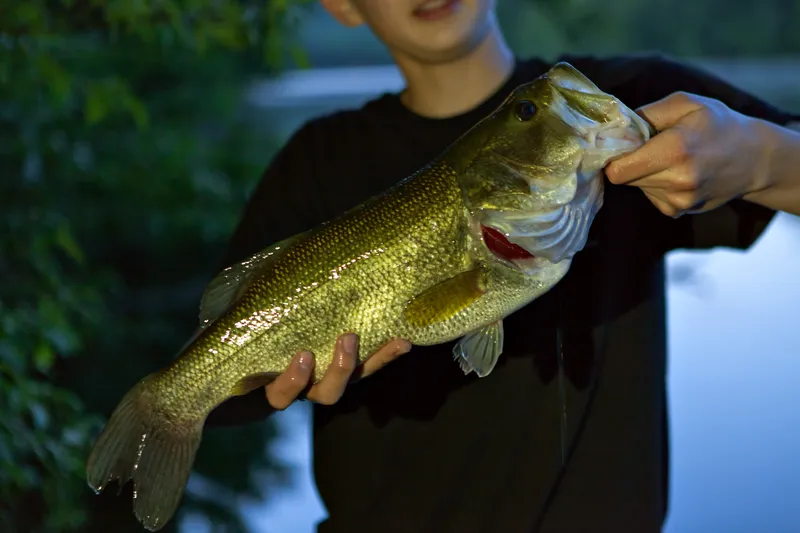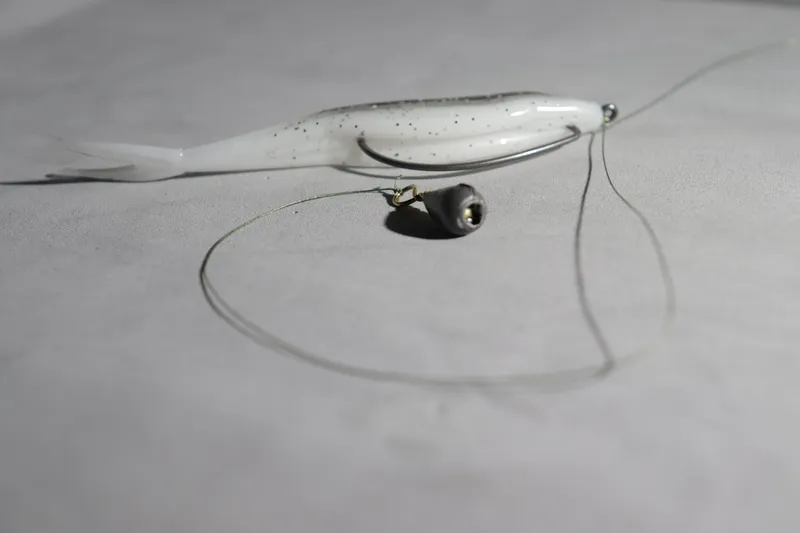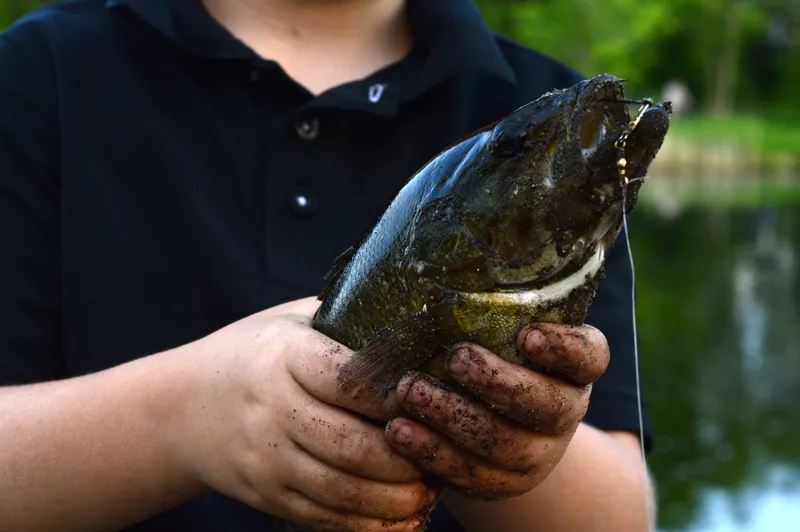If you’re an angler looking to up your game and catch more bass, then drop shot fishing should be on your radar. This technique has been around for decades but has recently gained popularity due to its effectiveness in catching fish.
Drop shot fishing is a finesse technique that involves suspending a baited hook above the bottom of the water column. It’s especially useful when targeting finicky or lethargic fish that might not be interested in more aggressive lures.

The drop shot rig consists of a weight tied at the end of your line and a hook tied about 12-18 inches above it. By keeping the bait off the bottom, you can entice fish who might not otherwise bite.
The technique is also versatile; it can be used in deep or shallow water, clear or murky conditions, and works well for both smallmouth and largemouth bass. In general, drop shot fishing is an excellent alternative when other techniques aren’t producing results.
The Effectiveness Of Drop Shot Fishing
When it comes to bass fishing techniques, few are as effective as drop shotting. There are several reasons why anglers swear by this method:
Firstly, because it allows you to present your bait at various depths within the water column while keeping it stationary. This makes it easier to locate where the fish are biting.
Secondly, unlike other techniques where there’s usually only one chance to set the hook properly at first bite – with drop shotting – there’s more opportunity because no live bait is being used (usually) so there’s less resistance when reeling in which means that setting your hook will have fewer false positives. Since most bass anglers tend towards using lures which mimic live prey, drop shotting can be an effective alternative because of its finesse presentation; it’s a technique that requires patience and precision, but the payoff can be huge.
Drop shotting is an effective bass fishing technique that can help you catch more fish. Whether you’re a beginner or an experienced angler, mastering this technique takes time and practice but once mastered it will become one of your go-to techniques when other methods aren’t working.
Rigging The Drop Shot
Choosing The Right Hook And Weight
When it comes to choosing the right hook and weight for your drop shot rig, there are a few things to consider. For starters, you’ll want to choose a hook that is sharp enough to penetrate the fish’s mouth but not too large that it will spook them.
A size 1 or 2 hook should suffice for most situations. As for the weight, you’ll want to select one that allows you to keep your bait at the desired depth without dragging it along the bottom.
No products found.
A general rule of thumb is to use a weight that is about 1/8th of an ounce per foot of water depth. So if you’re fishing in 10 feet of water, use a 1-ounce weight.
Tying The Knot Correctly
One of the most important aspects of rigging a drop shot is tying your knot correctly. There are various types of knots you can use, but one popular option is the Palomar knot. To tie this knot, double up about six inches of line and pass it through the eye of your hook or weight.
Tie an overhand knot with both ends around your mainline and pull tight. Next, tie another overhand knot in just one end around your mainline about six inches above your first knot.
Then pull this second knot down towards your first so that it creates a loop in between them. Pass your hook or weight through this loop and tighten everything up by pulling on both ends of your line.
Adding Bait To Your Hook
The final step in rigging a drop shot is adding bait to your hook. There are many types of baits you can use such as worms or minnows, but some anglers prefer artificial lures like soft plastics.
Simply thread your bait onto your hook, making sure it’s securely in place. You can also add scent or attractant to make it more appealing to the fish.
Just remember, less is often more when it comes to bait. Use just enough to entice the fish, but not so much that it looks unnatural.
Casting Techniques
Proper Casting Form
One of the most crucial aspects of drop shot fishing is having proper casting form. This technique requires a soft and accurate presentation, so you’ll need to learn how to cast with precision. Start by holding the rod at a 45-degree angle and making a smooth, controlled back cast.
When you’re ready to cast forward, smoothly flick your wrist to launch the bait towards your target. It’s also important to remember not to overpower your cast.
You don’t need to throw the bait as far as possible – instead, focus on casting with accuracy and finesse. With practice, you’ll be able to consistently land your bait exactly where you want it.
Adjusting For Wind And Water Conditions
When drop shot fishing, it’s important to adjust your casting technique based on wind and water conditions. On windy days, you may need more power in order for your bait to reach its intended target. Conversely, when fishing in calm waters or targeting skittish fish, a softer presentation may be necessary.
Pay attention to the direction of the wind as well – casting into the wind will require more power than casting with it at your back. Make small adjustments until you find what works best for that particular day’s conditions.
Identifying Potential Hot Spots
Drop shot fishing requires an ability to identify potential hot spots where bass are likely hiding out. Look for structures such as rocks or logs that could provide cover for fish.
Additionally, keep an eye out for changes in water depth or underwater features like drop-offs that can attract fish. Another great way of finding hot spots is through trial and error – try different areas until you start getting bites consistently.
Remember that not every spot will hold fish every time, so it’s important not to get discouraged if one area doesn’t produce. Keep exploring and you’re bound to find a honey hole eventually!
Catching More Bass With Drop Shot Fishing

Knowing When To Set The Hook
One of the biggest mistakes that novice drop shot anglers make is setting the hook too soon or too late. If you set the hook too soon, you will miss many potential bites because the fish hasn’t fully engulfed your bait yet. On the other hand, if you set it too late, you may give the fish enough time to spit out your bait.
The key is to wait until you feel a solid tug on your line and see a bend in your rod before setting the hook. This means that the fish has fully committed to eating your bait and is now trapped.
It takes practice to master this technique, so don’t get discouraged if you miss some bites in the beginning. With time and experience, you’ll learn how to detect even subtle changes in tension on your line, allowing you to set the hook with confidence.
Playing The Fish Properly
Once you’ve hooked a bass on a drop shot rig, it’s important to play it properly in order to avoid losing it. The first thing you should do is keep steady pressure on your line by reeling it in slowly but steadily. Avoid jerky movements or sudden pulls that could cause the fish to shake itself loose.
No products found.
If a bass starts jumping out of the water or thrashing around aggressively, be prepared for it to make a run for cover like a nearby weed bed or rock pile. You’ll need to apply more pressure and use side-to-side movements with your rod tip while reeling in order to steer it away from obstructions.
Remember that patience is key when playing a fish; don’t rush things or try to force it into submission. Instead, keep up steady pressure while letting the drag on your reel do its job; this will tire out even large bass over time.
Tips For Increasing Your Catch Rate
Even experienced drop shot anglers can always learn new tricks to increase their catch rate. One tip is to vary the speed and rhythm of your retrieves in order to mimic the movement of different types of bait fish. Another is to experiment with the depth at which you’re fishing; sometimes bass will be feeding at different depths depending on factors like water temperature and weather conditions.
Another important strategy is to pay close attention to the details of your rigging and presentation. Make sure that your hook is sharp and that you’re using bait that matches the local forage.
You may also want to adjust the length of your leader or change up your weight size in order to find what works best in a particular fishing spot. Don’t forget about the importance of patience, persistence, and observation.
Sometimes it takes a while for a bass to become interested in your bait, so be willing to cast multiple times into an area before giving up on it. And be observant; if you notice fish actively feeding near a drop off or other structure, make sure you fish that area thoroughly before moving on!
Advanced Techniques For Drop Shot Fishing
Using Electronics To Locate Fish
If you want to take your drop shot fishing to the next level, you need to start using electronics. Fish finders are an essential tool for any serious angler, especially when drop shot fishing. With a fish finder, you can locate schools of bass and identify the depth they are swimming at.
This information can give you a significant edge in catching more fish. Another electronic tool that many anglers use is a GPS unit or mapping app.
These devices can help you locate underwater structures such as ledges, humps, and drop-offs where bass like to hang out. Once you have identified these areas, mark them on your GPS or map so that you can return to them on future trips.
Experimenting With Different Baits And Presentations
One of the great things about drop shot fishing is that it allows for endless experimentation with different baits and presentations. Start by trying different types of soft plastic baits such as worms, grubs, and minnow imitations. Varying the size and color of your bait can also make a big difference in triggering bites.
No products found.
You can also experiment with different rigging techniques such as nose hooking or wacky rigging your bait instead of Texas rigging it. Varying your presentation by twitching your rod tip or dragging your bait slowly along the bottom can also trigger more bites from finicky bass.
Adapting To Changing Weather Conditions
One of the most important things that separates successful anglers from unsuccessful ones is their ability to adapt to changing weather conditions. In low light or overcast conditions, bass tend to move shallower looking for food while in bright sunny conditions they will often retreat deeper into cover. Pay attention to water temperature as well since it affects bass behavior.
During the summer months when water temperatures are high, bass tend to be sluggish and will often move to deeper water where it’s cooler. Conversely, during the spring and fall when water temperatures are cooler, bass will move shallower in search of warmer water.
By using electronics to locate fish, experimenting with different baits and presentations, and adapting to changing weather conditions, you can significantly increase your success rate drop shot fishing for bass. Remember that fishing is a learning process and there is always something new to discover or try.
Are You Ready To Try Drop Shot Fishing?

If you’ve read this far, you’re probably intrigued by the idea of drop shot fishing. And why wouldn’t you be?
It’s a versatile technique that can catch bass in a variety of conditions. Here are some key takeaways to keep in mind:
First and foremost, rigging your drop shot correctly is crucial for success. Use the right hook and weight for your situation, and tie your knot carefully.
Practice adding bait to the hook so that it stays secure during casting. Next, practice casting until you’re comfortable with both accuracy and distance.
Pay attention to wind and water conditions so that you can adjust your cast as needed. Keep an eye out for hot spots where bass are likely to hang out.
Don’t be afraid to experiment with different baits or presentations based on what’s working for other anglers in the area. And always pay attention to weather changes – sometimes even small fluctuations can make a big difference in whether or not the fish are biting.
Final Thoughts
Drop shot fishing can be incredibly rewarding once you get the hang of it. It allows for precise presentation near structures and can help catch more fish when other techniques fail. One thing that makes drop shot fishing particularly fun is its versatility – it works well for both beginners and experienced anglers alike, as well as in various types of water bodies such as lakes, rivers, or ponds.
So why not give it a try on your next bass fishing trip? With these tips in mind, hopefully you’ll have the knowledge and confidence needed to make your next outing a success!
Frequently Asked Questions
Catching big bass on drop shot requires finding the right location, lure selection, and a good drop shot technique such as dragging or hopping. Additionally, it’s essential to maintain sensitivity in the line and to set the hook fast when the fish bite.
The best line for drop shot bass fishing is typically a fluorocarbon line with low stretch and high sensitivity, usually in the 6-12 lb test range. This type of line allows for better control over the bait and sensitivity to detect even subtle bites.
Drop shot is a highly effective method for catching bass, especially in deep waters or when the fish are finicky and not actively biting. It’s also a versatile technique that allows for a variety of bait options and presentations.
To increase your chances of catching bigger fish with drop shot, use larger bait or switch to a heavier weight to get your lure deeper in the water. Additionally, focus on finding areas with high fish concentration and experiment with different drop shot techniques.
The recommended depth for drop shot fishing varies depending on the location, time of day, and water temperature. Generally, starting at 10-15 feet and adjusting based on the fish’s behavior is a good strategy.